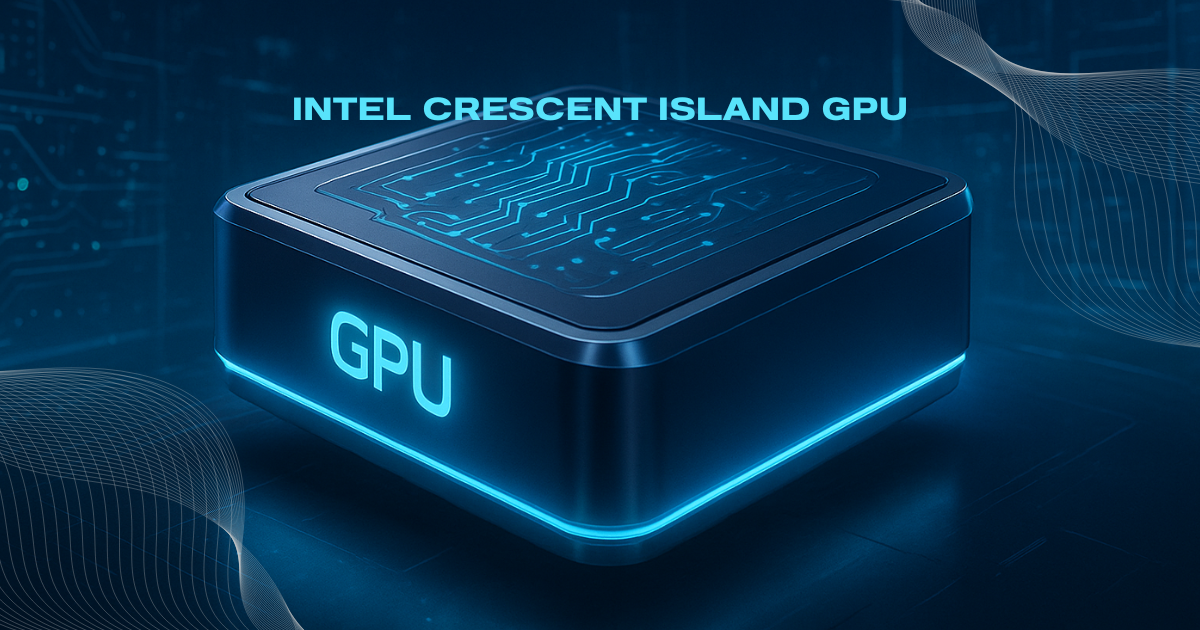From the start, sportsgamingdaily wants you to know: Intel’s return to the AI GPU arena through the Intel Crescent Island GPU is more than a hardware debut. It signals an ambition to reshape how inference is handled in 2026. Intel is reentering the battleground of AI chips with bold claims, and this new GPU may stake its claim. In this post, we dissect the news, the context, and what’s likely next in Intel’s AI roadmap.
Intel’s announcement confirms that Crescent Island is built specifically as an Intel AI inference GPU, optimized not for training massive models but for serving them efficiently. Rather than chasing brute compute, Intel emphasizes cost, memory, and power. The design is based on an Xe3P architecture and carries 160 GB of LPDDR5X memory, a choice that surprises many.
Because sportsgamingdaily covers tech shifts broadly, we’ll also compare against rivals. Even though Nvidia dominates, Intel hopes that Crescent Island helps turn heads and captures usable share in inference workloads. The rest of this blog breaks down what Crescent Island offers, what it hints about Intel’s ambitions, and how it competes.
Why Intel is reentering the AI chip market
Intel Crescent Island GPU once dominated general-purpose computing. But it lagged in AI accelerators, letting Nvidia, AMD, and others take the lead. With Crescent Island, Intel reenters the AI chip market aiming at inference, a domain where efficiency and cost per token matter most.
At the OCP Global Summit, Intel’s CTO stated that future AI workloads shift from training to serving, and that the company will pursue a predictable, annual cadence of AI chip launches. Rather than being a one-off, the Crescent Island GPU could be the beginning of a new line. Intel’s renewed push shows it won’t just dabble; it’s aiming for sustained presence.
The Intel reenters AI chip market narrative is more than marketing. Intel recently took serious steps: it mothballed or scaled back earlier GPU and AI efforts (Gaudi, Falcon Shores), and now refocuses on inference, modular systems, and heterogeneous stacks.
Intel Crescent Island GPU By emphasizing interoperability and open architecture, Intel hopes to build trust among cloud and enterprise customers reluctant to lock into monolithic stacks. If it succeeds, Crescent Island could anchor Intel’s comeback.
Crescent Island GPU specifications and features
Let’s dive into what we know so far about Crescent Island GPU specs what Intel has revealed, what’s inferred, and where gaps remain.
- The GPU is inference-only, not built for training. That means it focuses on low latency, mixed precision, and memory.
- It uses the new Xe3P architecture, an enhancement over Xe3, tuned for lower power and cost, especially in air-cooled server environments.
- Crescent Island will carry 160 GB of LPDDR5X memory, a surprising move compared to HBM used by competitors. The memory format suggests Intel prioritizes capacity and cost.
- The design is being optimized for air-cooled enterprise servers meaning Intel is not going for exotic cooling or extreme power draws.
- The GPU aims to support a broad range of data types relevant to inference, e.g. INT8, INT4, FP16, etc. That flexibility is essential for token-based services.
While Intel Crescent Island GPU hasn’t published performance numbers, speculation suggests they may partition the memory across sub-GPUs (e.g. two 320-bit interfaces) or a single wide interface.
Intel Crescent Island GPU expects customer sampling in second half of 2026, with broader deployment possibly following in 2027.
Because many questions remain memory bandwidth, compute units, power envelope Crescent Island’s full potential is yet to be seen. But its baseline specs already tell us about Intel’s tradeoffs: big memory, energy efficiency, and flexibility over raw compute.
What Crescent Island tells about Intel’s AI ambitions for 2026
By launching Crescent Island, Intel is signaling several strategic directions and ambitions.
First, Intel doubles down on AI inference as its battlefront. Instead of trying to outdo Nvidia’s training GPUs, Intel picks a domain where efficiency, cost, and scalability matter most. The move is sensible: inference is where most AI workloads live in production.
Second, Intel’s goal is to rebuild credibility in the AI hardware space. After missing the generative AI wave, Intel now tries a comeback. sportsgamingdaily readers should note: this is a comeback effort as much as a technical effort.
Third, Intel bets on modular and open architecture. It argues that customers need freedom to mix and match hardware and software. Rather than locking users into closed stacks, Intel wants to present Crescent Island as a node in a flexible stack.
Fourth, Intel signals a shift in its release cadence. Whereas in the past, GPU and AI launches were sporadic, Intel now promises a regular annual pace. This will be crucial if it wants to survive long-term.
Finally, Intel’s approach lays groundwork for integration across its ecosystem from Xeon CPUs to AI PCs to edge devices. Crescent Island may serve as a pillar in a unified AI hardware roadmap.
In short, the Crescent Island GPU is not just a chip; it’s a statement. Intel wants to be taken seriously again in AI.
Intel vs Nvidia and others: competitive landscape
To assess Intel Crescent Island GPU chances, we need to compare against existing players, especially Intel vs Nvidia GPUs.
Nvidia currently dominates inference and training, backed by software ecosystem, model integrations, and deep partnerships. Their GPU stack (e.g. H100, upcoming Rubin) still leads in throughput and performance per watt. Intel must overcome both technical and ecosystem inertia.
Intel Crescent Island GPU diverges by using LPDDR5X instead of HBM. This gives Crescent Island higher memory capacity per dollar and easier supply chain, though bandwidth may lag. Other top GPUs use HBM3E or even HBM4.
If Intel’s memory bandwidth and compute efficiency are competitive, the larger 160 GB memory could let it host bigger models or reduce sharding, a real advantage. But if bandwidth gets bottlenecked, many AI workloads may suffer.
The architecture also matters. Nvidia’s GPUs and software ecosystem (CUDA, cuDNN, etc.) are mature. Intel Crescent Island GPU will need robust software support and ecosystem adoption for Xe3P and Crescent Island to succeed.
Still, the fact that Nvidia recently invested $5B in Intel (taking ~4% stake) suggests some stake alignment; perhaps Nvidia sees value in Intel’s return.
In the broader field, AMD and other AI hardware players also compete. Intel Crescent Island GPU must carve a niche, and its path through inference and memory-centric design may give it an opening. But the pressure is high.
What to watch next: roadmap, sampling, metrics
If you follow sportsgamingdaily, here’s what I’ll be watching closely:
- Benchmark metrics: token latency, throughput, energy per inference, memory bandwidth. These will tell whether Crescent Island can compete.
- Sampling and adoption: Which cloud and enterprise customers will take early access in 2H 2026?
- Software stack: Will Intel deliver optimized libraries, toolchains, driver support, and integration with popular AI frameworks?
- Successive chips: Will the annual cadence hold? What comes after Crescent Island in 2027 and 2028?
- Deployment scale: Can Intel scale production, warranty, and support to meet demand and maintain pricing?
If all goes well, Crescent Island can mark the turning point in Intel’s comeback in the AI GPU market.
Conclusion
The Intel Crescent Island GPU is more than just a chip announcement it’s a bold statement of intent. By focusing on inference, deploying 160 GB LPDDR5X memory, and leaning on Xe3P architecture, Intel Crescent Island GPU aims to disrupt entrenched norms in AI acceleration. While many details remain hidden, the path is now clear: Intel wants a serious seat at the inference hardware table.
sportsgamingdaily will keep you posted as the journey unfolds. The next year will be pivotal: if Crescent Island delivers as promised, Intel Crescent Island GPU may reassert itself among AI GPU contenders. And if it stumbles, it will reveal just how steep the climb is to challenge Nvidia and others. So far, the signs are promising, and 2026 may be the year Intel’s AI ambitions begin to take real form. sportsgamingdaily expects many more chapters to this story.










